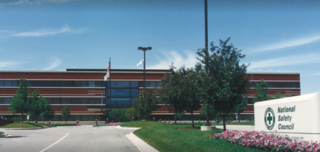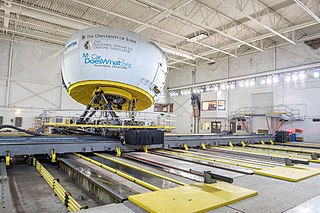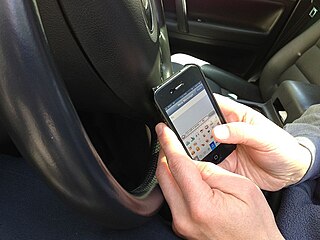Related Research Articles

Driving is the controlled operation and movement of a land vehicle, including cars, motorcycles, trucks, and buses. Permission to drive on public highways is granted based on a set of conditions being met and drivers are required to follow the established road and traffic laws in the location they are driving. The word driving, has etymology dating back to the 15th century and has developed as what driving has encompassed has changed from working animals in the 15th to automobiles in the 1800s. Driving skills have also developed since the 15th century with physical, mental and safety skills being required to drive. This evolution of the skills required to drive have been accompanied by the introduction of driving laws which relate to not only the driver but the driveability of a car.

Automotive safety is the study and practice of automotive design, construction, equipment and regulation to minimize the occurrence and consequences of traffic collisions involving motor vehicles. Road traffic safety more broadly includes roadway design.

Driving under the influence (DUI) is the offense of driving, operating, or being in control of a vehicle while impaired by alcohol or drugs, to a level that renders the driver incapable of operating a motor vehicle safely. Multiple other terms are used for the offense in various jurisdictions.

The National Traffic and Motor Vehicle Safety Act was enacted in the United States in 1966 to empower the federal government to set and administer new safety standards for motor vehicles and road traffic safety. The Act was the first mandatory federal safety standards for motor vehicles. The Act created the National Highway Safety Bureau. The Act was one of a number of initiatives by the government in response to increasing number of cars and associated fatalities and injuries on the road following a period when the number of people killed on the road had increased 6-fold and the number of vehicles was up 11-fold since 1925. The reduction of the rate of death attributable to motor-vehicle crashes in the United States represents the successful public health response to a great technologic advance of the 20th century—the motorization of the United States.

The National Safety Council (NSC) is a 501(c)(3) nonprofit, public service organization promoting health and safety in the United States. Headquartered in Itasca, Illinois, NSC is a member organization, founded in 1913 and granted a congressional charter in 1953. Members include more than 55,000 businesses, labor organizations, schools, public agencies, private groups and individuals.

Mobile phone use while driving is common but it is dangerous due to its potential for causing distracted driving and subsequent crashes. Due to the number of crashes that are related to conducting calls on a phone and texting while driving, some jurisdictions have made the use of calling on a phone while driving illegal in an attempt to curb the practice, with varying levels of efficacy. Many jurisdictions have enacted laws making handheld mobile phone use illegal. Many jurisdictions allow use of a hands-free device. Driving while using a hands-free device has been found by some studies to provide little to no benefit versus holding the device itself and carrying on a conversation. In some cases restrictions are directed only at minors, those who are newly qualified license holders, or to drivers in school zones. In addition to voice calling, activities such as texting while driving, web browsing, playing video games, or phone use in general may also increase the risk of a crash.

The Driving Safety Research Institute (DSRI) at the University of Iowa College of Engineering houses the National Advanced Driving Simulator (NADS-1) and a fleet of instrumented on-road research vehicles. The NADS-1 is one of the largest ground vehicle driving simulators in the world.

Transportation safety in the United States encompasses safety of transportation in the United States, including automobile crashes, airplane crashes, rail crashes, and other mass transit incidents, although the most fatalities are generated by road incidents annually killing 32,479 people in 2011 to over 42,000 people in 2022. The number of deaths per passenger-mile on commercial airlines in the United States between 2000 and 2010 was about 0.2 deaths per 10 billion passenger-miles. For driving, the rate was 150 per 10 billion vehicle-miles: 750 times higher per mile than for flying in a commercial airplane. For a person who drives a million miles in a lifetime this amounts to a 1.5% chance of death.
Aggressive driving is defined by the National Highway Traffic Safety Administration as the behaviour of an individual who "commits a combination of moving traffic offences so as to endanger other persons or property."
Injury prevention is an effort to prevent or reduce the severity of bodily injuries caused by external mechanisms, such as accidents, before they occur. Injury prevention is a component of safety and public health, and its goal is to improve the health of the population by preventing injuries and hence improving quality of life. Among laypersons, the term "accidental injury" is often used. However, "accidental" implies the causes of injuries are random in nature. Researchers prefer the term "unintentional injury" to refer to injuries that are nonvolitional but often preventable. Data from the U.S. Centers for Disease Control show that unintentional injuries are a significant public health concern: they are by far the leading cause of death from ages 1 through 44. During these years, unintentional injuries account for more deaths than the next three leading causes of death combined. Unintentional injuries also account for the top ten sources of nonfatal emergency room visits for persons up to age 9 and nine of the top ten sources of nonfatal emergency room visits for persons over the age of 9.

Vehicle safety technology (VST) in the automotive industry refers to the special technology developed to ensure the safety and security of automobiles and their passengers. The term encompasses a broad umbrella of projects and devices within the automotive world. Notable examples of VST include geo-fencing capabilities, remote speed sensing, theft deterrence, damage mitigation, vehicle-to-vehicle communication, and car-to-computer communication devices which use GPS tracking.

A traffic collision, also known as a motor vehicle collision, or car crash, occurs when a vehicle collides with another vehicle, pedestrian, animal, road debris, or other moving or stationary obstruction, such as a tree, pole or building. Traffic collisions often result in injury, disability, death, and property damage as well as financial costs to both society and the individuals involved. Road transport is statistically the most dangerous situation people deal with on a daily basis, but casualty figures from such incidents attract less media attention than other, less frequent types of tragedy. The commonly used term car accident is increasingly falling out of favor with many government departments and organizations, with the Associated Press style guide recommending caution before using the term. Some collisions are intentional vehicle-ramming attacks, staged crashes, vehicular homicide or vehicular suicide.

Texting while driving, also called texting and driving, is the act of composing, sending, or reading text messages on a mobile phone while operating a motor vehicle. Texting while driving is considered extremely dangerous by many people, including authorities, and in some places has either been outlawed or restricted. As a form of distracted driving, texting while driving significantly increases the chances that a driver will be involved in a motor vehicle accident.
Impact Teen Drivers is an organization intended to help teens reduce their risk of being involved in auto collisions, particularly those caused by everyday distractions and inexperienced decision making.

Distracted driving is the act of driving while engaging in other activities which distract the driver's attention away from the road. Distractions are shown to compromise the safety of the driver, passengers, pedestrians, and people in other vehicles.

Alcohol-related traffic crashes are defined by the United States National Highway Traffic Safety Administration (NHTSA) as alcohol-related if either a driver or a non-motorist had a measurable or estimated BAC of 0.01 g/dl or above.

Various laws in the United States regulate the use of mobile phones and other electronics by motorists. Different states take different approaches. Some laws affect only novice drivers or commercial drivers, while some laws affect all drivers. Some laws target handheld devices only, while other laws affect both handheld and handsfree devices.

People who are driving as part of their work duties are an important road user category. First, workers themselves are at risk of road traffic injury. Contributing factors include fatigue and long work hours, delivery pressures, distractions from mobile phones and other devices, lack of training to operate the assigned vehicle, vehicle defects, use of prescription and non-prescription medications, medical conditions, and poor journey planning. Death, disability, or injury of a family wage earner due to road traffic injury, in addition to causing emotional pain and suffering, creates economic hardship for the injured worker and family members that may persist well beyond the event itself.

Tesla Autopilot is an advanced driver-assistance system (ADAS) developed by Tesla that amounts to partial vehicle automation. Tesla provides "Base Autopilot" on all vehicles, which includes lane centering and traffic-aware cruise control. Owners may purchase or subscribe to Full Self-Driving (FSD) which adds semi-autonomous navigation that responds to traffic lights and stop signs, lane change assistance, self-parking, and the ability to summon the car from a garage or parking spot.
The passenger problem is the inability of technological systems designed for use in a moving vehicle to differentiate between a driver and a passenger.
References
- ↑ "Teen Drivers: Get the Facts - Motor Vehicle Safety - CDC Injury Center". www.cdc.gov. 16 October 2017. Retrieved 17 January 2018.
- ↑ NHTSA Teen Driver Resources. Retrieved November 9, 2010.
- ↑ National Highway Traffic Safety Administration (NHTSA) via The Fitch Law Firm.
- ↑ NTHSA National Teen Driver Safety Week Resources.. Retrieved October 26, 2010.
- ↑ “Pennsylvania Legislators Propose National Teen Driver Safety Week for October”. PRNewswire. Retrieved October 22, 2010.
- ↑ "Parachute". www.parachutecanada.org. Retrieved 17 January 2018.
- ↑ “Jesse McCartney, Oprah and Mom Say, ‘Step Away From the Phone!’” .Tonic website. Retrieved October 26, 2010.
- ↑ “Distracted driving epidemic: U.S. Transportation Secretary LaHood calls issue a ‘personal crusade’”. Seacoast Online. Retrieved October 26, 2010.